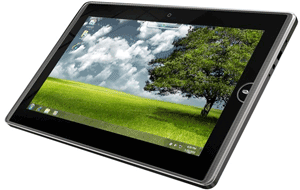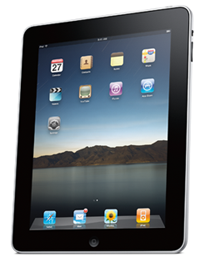Twitterific for iPad is nicely done, but I’m psyched by the prospect of Tweetie Twitter for iPad…
Tag Archives | Tablets
Mac Forever?
“When we were an agrarian nation, all cars were trucks, because that’s what you needed…PCs are going to be like trucks. They’re still going to be around. They’re still going to have a lot of value. But they’re going to be used by one out of x people…this transformation is going to make some people uneasy.“–Steve Jobs, at the Wall Street Journal’s D8 conference last week
“Flash was created during the PC era…”–Steve Jobs, in “Thoughts on Flash”
“Maybe next year we will focus primarily on the Mac. Just the normal cycle of things. No hidden meaning here.”–Steve Jobs, reassuring a developer who was concerned about the iPhone-centric WWDC 2010
17 comments
Got an iPad? Take Our Satisfaction Survey
 iPad reviews are all very well. But the iPad has been out for two months now–and at this point, the most interesting opinion about it is the collective one that’s been formed by the people who own and use it.
iPad reviews are all very well. But the iPad has been out for two months now–and at this point, the most interesting opinion about it is the collective one that’s been formed by the people who own and use it.
Which is why we’re conducting a survey on the state of iPad satisfaction. If you’ve got an iPad, please take it–and tell your friends who have one, too. Answering our questions will take only a few minutes, and we’ll use your feedback in an upcoming story. (Here, incidentally, are past articles we did reporting on our iPhone and Windows 7 surveys.)
Click here to take the survey.
[The survey is closed–thanks to everyone who participated, and stay tuned for results.]
14 comments
Microsoft Unveils a (Somewhat) Tablet-Friendly Version of Windows
It still isn’t clear what Microsoft’s long-term tablet strategy is going to be. But here’s a bit of new info: At Computex in Tapei, it announced Windows Embedded Compact 7 (gotta love those Microsoft product names!), a slimmed-down version of Windows capable of running on minimalist tablet hardware, with support for touchscreens. As Engadget reports, the company also showed off a passel of Windows tablets, albeit under glass.
I still think that a serious version of Windows for tablets needs a substantially new user interface, not to mention a whole infrastructure for encouraging third-party developers to write touch-centric apps. Windows Embedded Compact 7 doesn’t appear to be that OS…
One comment
Noteworthy Newsreader
Pulse, a new RSS reader for the iPad, isn’t perfect. (It supports a maximum of twenty feeds, and I added a bunch of feeds which then mysteriously disappeared.) But I’m still as excited about it as I am about any of the iPad apps that are tied to a specific magazine or newspaper. It’s got a highly visual, touch-driven interface that was born to live on a device like this–and if you’ve got an iPad and consume content, it’s $4 well spent.
4 comments
In Search of Microsoft's Tablet Strategy
 It’s Memorial Day in the U.S., but in Taipei, it’s time for Computex–the show that serves as an excellent freeze-frame of what the PC industry is excited about at the moment. Judging from the news so far, what it’s excited about is the iPad.
It’s Memorial Day in the U.S., but in Taipei, it’s time for Computex–the show that serves as an excellent freeze-frame of what the PC industry is excited about at the moment. Judging from the news so far, what it’s excited about is the iPad.
As Engadget is reporting, Asus is showing off something called the Eee Pad at the show–a vaguely iPad-esque looking device that runs Windows 7, packs an Intel ultra-low voltage CPU, and (like the iPad) claims ten hours of battery life on a charge. It’s safe to say that Asus still has heavy lifting to do to make the Eee Pad a reality: It isn’t planning to ship it until next year. By then, it’ll face competition from other Windows 7 tablets, such as this Computex debutante from MSI, not to mention Android tablets (MSI is showing one of those, too)
9 comments
Wired's iPad App: Finally Here, Still a Work in Progress
For months, Wired has been showing off a splashy prototype tablet edition of its magazine at industry confabs:
It’s a knockout of a demo–but I keep saying that it’s time for fewer digital magazine prototypes and more ones that real people can buy. And Wired’s magazine app is now a reality, in the form of a $4.99 iPad app you can buy from the App Store. It was created in collaboration with Adobe, and apparently sidesteps any development techniques which Apple would have problems with.
This first iPad issue is a partial implementation of the dazzler from the video. It’s got the rich-media elements: The cover story on Pixar includes a clip from the movie and a video tour of the studio, for instance. The app does a remarkably good job of reformatting pages to look good in either portrait or landscape mode–an origami-like challenge that makes my head hurt just thinking about it. The fancy thumbnail-based navigation is there. And the whole thing has the visual splendor which print Wired has always had and Wired’s (excellent) Web site does not.
8 comments
Ten Million iPads a Year? Not So Silly
 All Things Digital’s John Paczkowski is reporting about an analyst report that says the iPad is outselling the Mac and closing on the iPhone, at 200,000 units per week–putting Apple on a pace to sell eight million iPads this year, according to the analyst firm’s forecast. That’s a lot of iPads–and if the firm is right, it means that the rumors from months ago that Apple expected to sell ten million iPads in the gizmo’s first year on the market aren’t so nutty.
All Things Digital’s John Paczkowski is reporting about an analyst report that says the iPad is outselling the Mac and closing on the iPhone, at 200,000 units per week–putting Apple on a pace to sell eight million iPads this year, according to the analyst firm’s forecast. That’s a lot of iPads–and if the firm is right, it means that the rumors from months ago that Apple expected to sell ten million iPads in the gizmo’s first year on the market aren’t so nutty.
(Of course, when folks were doubting that Apple could sell ten million iPads in a year, many of them were expecting the “iSlate” to sell for a thousand bucks or so. Only Apple knew that the most basic model would go for a relatively affordable $500.)
After the jump, a rerun of the numbers on sales of past Apple products I pulled together when the ten-million-iPads rumor first surfaced. Now that we know a lot more about the iPad, I don’t see why it can’t sell about as many units in a year as the iPhone did last year, assuming that the international rollout doesn’t suffer any further major hitches…
10 comments
The iPad. Of 2000. As Envisioned in 1988
 In the late 1980s, Apple Computer was better known for fantasizing about breakthrough products than making them. Most famously, CEO John Sculley envisioned a futuristic gizmo called the Knowledge Navigator–featuring a bowtied digital assistant–in his 1987 book Odyssey. It made for a mighty impressive futuristic video.
In the late 1980s, Apple Computer was better known for fantasizing about breakthrough products than making them. Most famously, CEO John Sculley envisioned a futuristic gizmo called the Knowledge Navigator–featuring a bowtied digital assistant–in his 1987 book Odyssey. It made for a mighty impressive futuristic video.
In September of the same year, Apple announced a competition it called “Project 2000.” Teams from a dozen universities were invited to submit papers about Knowledge Navigator-like concepts representing the PC of far-off 2000. An impressive panel of judges–Apple cofounder Steve Wozniak, personal-computing visionary Alan Kay, futurist Alvin Toffler, science fiction legend Ray Bradbury, and Encyclopaedia Britannica’s Diane Ravitch–judged the entries in early 1988.
A group from the University of Illinois at Urbana-Champaign won, for a paper titled TABLET: The Personal Computer of the Year 2000. “We seek something which fits comfortably into people’s lives while dramatically changing them,” the entry explained. And then it went on to describe a machine that was as different from the typical portable computer of the era as you could imagine.
The device was about the size of a paper notebook, and it packed a high-resolution color touchscreen with a virtual keyboard, gigabytes of solid-state storage, cellular connectivity, GPS, and a built-in microphone and speaker. Sophisticated software based on UNIX let you tap icons on a desktop and use pop-down menus to use it for note-taking, connecting to online services, driving directions, e-mail (complete with junk-mail filtering), social networking, 3D games, and both network TV shows and wacky user-generated video. Accessories included a wireless keyboard for those who preferred to touch type, and if you lost your tablet, a clever service even let you use the GPS to track it down.
12 comments
HP Slate: So Long Windows 7, Hiya WebOS?
I started out thinking that the rumor that HP was canceling its much-hyped Windows 7 “Slate PC” strained credulity. But it’s been a couple of weeks since the idea surfaced, and HP isn’t denying it. Which isn’t a good sign–if everything was fine, wouldn’t the company say so?
Now GottaBeMobile is reporting that an allegedly excellent source says that HP is ditching Windows 7 and replacing it with the operating system it just bought: Palm’s WebOS, on a slate code-named “Hurricane.” You’d think it would take awhile to reengineer WebOS to work well on a larger device, making a release in the next few months unlikely–or has Palm been secretly tackling that challenge all along?
